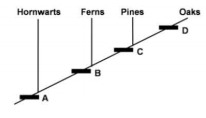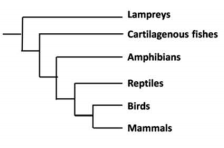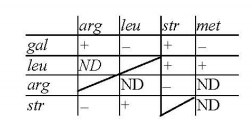 Multiple Choice Questions
Multiple Choice QuestionsIf gypsy moth egg density is 160 at time t and 200 at t + 1, what will be its value at time t + 3, assuming that egg density continues to increase at constant rate?
250
280
312
390
C.
312
The egg density at time t + 3 will be 312.
Match the following human diseases with their casual organisms.
| A. Sleeping sickness | i. Trypanosoma cruzi |
| B. Chagas disease | ii. Trypanosoma brucei |
| C. Elephantiasis | iii. Borrelia burgdorfei |
| D. Lyme disease | iv. Wuchereria bancrofti |
A - ii; B - iv; C - iii; D - i
A - i; B - ii; C - iv; D - iii
A - ii; B - i; C - iv; D - iii
A - ii; B - i; C - iv; D - iii
A - ii; B - i; C - iv; D - iii
Following is a cladogram showing phylogenetic relationships among a group of plants:

In the above representation, A, B, C, and D respectively represent.
xylem and phloem, embryo, flower, seed
embryo, xylem and phloem, seed, flower
embryo, xylem and phloem, flower, seed
xylem and phloem, flower, embryo, seed
Match major events in the history of life with Earth's geological period.
| Event | Geological period |
| A. First reptiles | i. Quaternary |
| B. First mammals | ii. Tertiary |
| C. First humans | iii. Cretaceous |
| D.First amphibians | iv. Triassic |
| v. Carboniferous | |
| vi. Devonian |
A - v; B - i; C - ii; D - v
A - v; B - iv; C - i; D - vi
A - vi; B - iv; C - ii; D - vi
A - iii; B - i; C - vi; D - v
For the following invertebrate structures/ organs, identify their major function and the animal group in which they are found:
Nematocyst (A), Protonephridia (B), Malpighian tubules (C), Radula (D)
A - Porifera, Skeletal support; B - Mollusca, excretion; C - Insecta, respiration; D - Anthozoa, prey capture
A - Anthozoa, prey capture; B - Planaria, excretion; C - Mollusca, excretion; D - Insecta, food processing
A - Planaria, excretion; B - Mollusca, respiration; C - Insecta, respiration; D - Porifera, prey capture
A - Anthozoa, prey capture; B - Planaria, excretion; C - Insecta, excretion; D - Mollusca, food processing

With reference to the phylogenetic tree presented above, which of the following statements is true?
Amphibians, reptiles, birds, and mammals share a common ancestor.
Birds are more closely related to reptiles than to mammals.
Cartilaginous fishes are the ancestors of amphibians.
Lampreys and mammals are not related.
Based on the table given below, which of the following option represents the correct match?
| Category | Plant species |
| A. Critically endangered | i. Chromolaena odorata |
| B. Vulnerable | ii. Dipterocarpus grandiflorus |
| C. Extinct | iii. Euphorbia mayuranthanii |
| D. Invasive | iv. Saraca asoka |
A - i; B iv; C - iii; D - ii
A - ii; B - iii; C - iv; D - i
A - i; B - iv; C - ii; D - iii
A - ii; B - iv; C - iii; D - i
Five bacterial markers were followed for a co-transduction experiment. The following table documents the observations of this experiment. '+' denotes co-transduction and '-' denotes lack thereof; 'ND' stands for not determined.

Pick the correct order in which the genes are arranged on the bacterial chromosome
str - gal - leu - arg - met
leu - met - arg - str - gal
leu - str - met - gal - arg
arg - gal - str - leu - met
A male mouse cell line has a large translocation from X chromosome into chromosome 1. When a GFP containing transgene is inserted in this chromosome 1 with translocation, it is often silenced. However, when inserted in the other homologue of chromosome 1 that does not contain the translocation, it is almost always expressed. Which of the following phenomenon best describes this effect?
Genome imprinting
Gene balance
Sex-specific expression
Dosage compensation
Two interacting genes (independently assorting) were involved in the same pathway. Absence of either gene's function leads to the absence of the end product of the pathway. A dihybrid cross involving the two genes is carried out. What fraction of the F2 progeny will show the presence of the end product?
1/4
3/4
9/16
15/16
